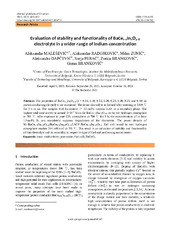Evaluation of stability and functionality of BaCe1-xInxO3-delta electrolyte in a wider range of indium concentration
2022
Аутори
Malesevic, AleksandarRadojkovic, Aleksandar
Zunic, Milan
Dapčević, Aleksandra

Perac, Sanja
Branković, Zorica

Brankovic, Goran
Чланак у часопису (Објављена верзија)
Метаподаци
Приказ свих података о документуАпстракт
The properties of BaCe1-xInxO3-delta (x = 0.05, 0.10, 0.15, 0.20, 0.25, 0.30, 0.35, and 0.40) as proton conducting electrolyte are examined. The dense electrolyte is formed after sintering at 1300 degrees C for 5 h in air. The samples with In content > 25 mol% contain In2O3 as a secondary phase. The highest total conductivity is around 5x10(-3) S/cm for BaCe0.75In0.25O3-delta in the wet hydrogen atmosphere at 700 degrees C. After exposure to pure CO2 atmosphere at 700 degrees C for 5 h, the concentrations of at least 15 mol% In can completely suppress degradation of the electrolyte. The power density of Ni-BaCe0.75In0.25O3-delta/BaCe0.75In0.25O3-delta/LSCF-BaCe0.75In0.25O3-delta fuel cell tested in wet hydrogen atmosphere reaches 264 mW/cm(2) at 700 degrees C. This result is an indication of stability and functionality of this electrolyte and its versatility in respect to type of fuel and performing environment.
Кључне речи:
ionic conductivity / perovskite / fuel cell / BaCeO3Извор:
Journal of Advanced Ceramics, 2022, 11, 3, 443-453Финансирање / пројекти:
- Министарство науке, технолошког развоја и иновација Републике Србије, институционално финансирање - 200053 (Универзитет у Београду, Институт за мултидисциплинарна истраживања) (RS-MESTD-inst-2020-200053)
- Министарство науке, технолошког развоја и иновација Републике Србије, институционално финансирање - 200135 (Универзитет у Београду, Технолошко-металуршки факултет) (RS-MESTD-inst-2020-200135)
DOI: 10.1007/s40145-021-0547-1
ISSN: 2226-4108
WoS: 000741953900002
Scopus: 2-s2.0-85122663644
Институција/група
Tehnološko-metalurški fakultetTY - JOUR AU - Malesevic, Aleksandar AU - Radojkovic, Aleksandar AU - Zunic, Milan AU - Dapčević, Aleksandra AU - Perac, Sanja AU - Branković, Zorica AU - Brankovic, Goran PY - 2022 UR - http://TechnoRep.tmf.bg.ac.rs/handle/123456789/4993 AB - The properties of BaCe1-xInxO3-delta (x = 0.05, 0.10, 0.15, 0.20, 0.25, 0.30, 0.35, and 0.40) as proton conducting electrolyte are examined. The dense electrolyte is formed after sintering at 1300 degrees C for 5 h in air. The samples with In content > 25 mol% contain In2O3 as a secondary phase. The highest total conductivity is around 5x10(-3) S/cm for BaCe0.75In0.25O3-delta in the wet hydrogen atmosphere at 700 degrees C. After exposure to pure CO2 atmosphere at 700 degrees C for 5 h, the concentrations of at least 15 mol% In can completely suppress degradation of the electrolyte. The power density of Ni-BaCe0.75In0.25O3-delta/BaCe0.75In0.25O3-delta/LSCF-BaCe0.75In0.25O3-delta fuel cell tested in wet hydrogen atmosphere reaches 264 mW/cm(2) at 700 degrees C. This result is an indication of stability and functionality of this electrolyte and its versatility in respect to type of fuel and performing environment. T2 - Journal of Advanced Ceramics T1 - Evaluation of stability and functionality of BaCe1-xInxO3-delta electrolyte in a wider range of indium concentration EP - 453 IS - 3 SP - 443 VL - 11 DO - 10.1007/s40145-021-0547-1 ER -
@article{
author = "Malesevic, Aleksandar and Radojkovic, Aleksandar and Zunic, Milan and Dapčević, Aleksandra and Perac, Sanja and Branković, Zorica and Brankovic, Goran",
year = "2022",
abstract = "The properties of BaCe1-xInxO3-delta (x = 0.05, 0.10, 0.15, 0.20, 0.25, 0.30, 0.35, and 0.40) as proton conducting electrolyte are examined. The dense electrolyte is formed after sintering at 1300 degrees C for 5 h in air. The samples with In content > 25 mol% contain In2O3 as a secondary phase. The highest total conductivity is around 5x10(-3) S/cm for BaCe0.75In0.25O3-delta in the wet hydrogen atmosphere at 700 degrees C. After exposure to pure CO2 atmosphere at 700 degrees C for 5 h, the concentrations of at least 15 mol% In can completely suppress degradation of the electrolyte. The power density of Ni-BaCe0.75In0.25O3-delta/BaCe0.75In0.25O3-delta/LSCF-BaCe0.75In0.25O3-delta fuel cell tested in wet hydrogen atmosphere reaches 264 mW/cm(2) at 700 degrees C. This result is an indication of stability and functionality of this electrolyte and its versatility in respect to type of fuel and performing environment.",
journal = "Journal of Advanced Ceramics",
title = "Evaluation of stability and functionality of BaCe1-xInxO3-delta electrolyte in a wider range of indium concentration",
pages = "453-443",
number = "3",
volume = "11",
doi = "10.1007/s40145-021-0547-1"
}
Malesevic, A., Radojkovic, A., Zunic, M., Dapčević, A., Perac, S., Branković, Z.,& Brankovic, G.. (2022). Evaluation of stability and functionality of BaCe1-xInxO3-delta electrolyte in a wider range of indium concentration. in Journal of Advanced Ceramics, 11(3), 443-453. https://doi.org/10.1007/s40145-021-0547-1
Malesevic A, Radojkovic A, Zunic M, Dapčević A, Perac S, Branković Z, Brankovic G. Evaluation of stability and functionality of BaCe1-xInxO3-delta electrolyte in a wider range of indium concentration. in Journal of Advanced Ceramics. 2022;11(3):443-453. doi:10.1007/s40145-021-0547-1 .
Malesevic, Aleksandar, Radojkovic, Aleksandar, Zunic, Milan, Dapčević, Aleksandra, Perac, Sanja, Branković, Zorica, Brankovic, Goran, "Evaluation of stability and functionality of BaCe1-xInxO3-delta electrolyte in a wider range of indium concentration" in Journal of Advanced Ceramics, 11, no. 3 (2022):443-453, https://doi.org/10.1007/s40145-021-0547-1 . .


